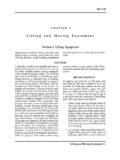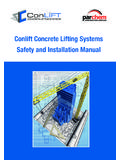Transcription of HID Inspection Guide Offshore - Health and Safety Executive
1 HID Inspection Guide Offshore Inspection of Mechanical Handling & Crane Operations Contents Summary Introduction Action Background Appendix 1 - The planning of mechanical handling operations and crane operations Appendix 2 - The control of portable mechanical handling equipment Appendix 3 - The thorough examination of lifting equipment and cranes Appendix 4 - The maintenance and Inspection of mechanical handling equipment Appendix 5 - The maintenance and Inspection of cranes Appendix 6 - The training and competence, the providing of information, and the supervision of personnel involved in mechanical handling operations and crane operations Appendix 7 - The undertaking of crane operations Appendix 8 - The undertaking of mechanical handling operations using portable lifting equipment Appendix 9 - The undertaking of mechanical handling operations on the drillfloor Appendix 10 - The lifting of personnel by cranes or winches Appendix 11 Performance Assessment Summary This guidance outlines an approach to the Inspection of dutyholder s arrangements for the management of Offshore mechanical handling operations.
2 Including crane operations and the management of Offshore lifting equipment . It also sets out the criteria for satisfactory and unsatisfactory performance factors against which the dutyholder will be rated. Reference is made to technical standards and guidance that inspectors will use to form an opinion for legal compliance. Introduction Although in recent years there has been a reduction in the number of incidents occurring during both Offshore mechanical handling operations and crane operations unfortunately they still continue to occur.
3 Tragically some of these incidents have resulted in serious injuries and fatalities. In addition an incident during mechanical handling or crane operations can have the potential to be an initiating event for a Page 1 of 40 major accident, such as a dropped load or a failed crane boom falling onto and rupturing a vessel or pipeline containing hydrocarbons. To ensure incidents do not occur they must be carried out in a safe manner and this can only be achieved if mechanical handling and crane operations are adequately planned, are undertaken by competent personnel, and utilise equipment that is both suitable for the task and in a safe condition.
4 Dutyholders must have an effective system in place for the management of mechanical handling operations and crane operations and these guidelines give inspectors guidance on how to inspect the suitability and effectiveness of a management system. This topic breaks down into ten core intervention sub topics. An overview of how to undertake an Inspection of each of these sub topics is included in the appendices. The use of this guidance will enable a consistent approach to be adopted for the Inspection of these sub topics Action This guidance should be used by IMT Inspectors; however it may be necessary to have some input from the relevant specialist inspectors where there are technical issues on which the IMT Inspector requires guidance.
5 The ten core Inspection sub topics are as follows: The planning of mechanical handling operations and crane operations The management of mechanical handling operations and crane operations The role of the Competent Person Risk Assessments lifting Plans Toolbox Talks The control of portable mechanical handling equipment The thorough examination of lifting equipment and cranes The maintenance and Inspection of mechanical handling equipment The maintenance and Inspection of cranes The training and competence, the providing of information, and the supervision of personnel involved in mechanical handling operations and crane operations.
6 The undertaking of crane operations The undertaking of mechanical handling operations using portable lifting equipment The undertaking of mechanical handling operations on the drillfloor The lifting of personnel by cranes or winches The details of how to undertake an Inspection of each of these sub topics is given in the attached appendices. The effective Inspection of these sub topics will include establishing that the dutyholders documented procedures are sufficiently robust and that the dutyholder is actually following their procedures. Page 2 of 40 Background The main legal requirements which are applicable to Mechanical Handling and Crane Operations come from the lifting Operations and lifting equipment Regulations (LOLER).
7 These Regulations implement the lifting provisions of the Amending Directive to the Use of Work equipment Directive. The Provision and Use of Work equipment Regulations (PUWER) apply to all work equipment including lifting equipment but LOLER deals with the specific risks associated with lifting equipment and lifting operations. Mechanical Handling may involve moving a load horizontally (pulling), or the raising and lowering of a load ( lifting ). PUWER will apply to both activities however the requirements of LOLER only become applicable when there is the raising or the lowering of a load.
8 LOLER applies to all lifting equipment on Offshore installations and all lifting operations undertaken on Offshore installations. In addition certain sections of LOLER apply to some specified operations undertaken from vessels in connection with Offshore installations. The Management of Health and Safety at Work Regulations (MHSWR) brings in the requirements for risk assessments to be carried out to identify the nature and level of risks associated with mechanical handling and crane operations. LOLER defines lifting equipment as work equipment for the lifting and lowering of loads and includes its attachments used for anchoring, fixing or supporting it.
9 lifting accessories are specific items of lifting equipment which are used to connect the load to the lifting machine (slings, shackles etc.). PUWER requires employers to ensure that work equipment is suitable for the purpose and additionally LOLER requires that lifting equipment is of adequate strength. The requirements for the strength of items of lifting equipment are specified in the Machinery Directive within the essential Health and Safety requirements to offset the particular hazards due to a lifting operation . The Supply of Machinery ( Safety ) Regulations brings in the requirements for persons who supply lifting equipment to ensure the lifting equipment meets the Machinery Directive essential Health and Safety requirements to offset the particular hazards due to a lifting operation.
10 Such equipment should be CE marked and accompanied by EC declaration of conformity. It should be noted that The Supply of Machinery ( Safety ) Regulations and the Machinery Directive do not apply to lifting equipment supplied for use on Mobile Offshore Drilling Units, Floating Production Units, or Floating Storage Units. However in practise non CE marked lifting equipment which meets the requirements of the Machinery Directive will generally be found on such installations together with lifting equipment manufactured to the American API standards. Page 3 of 40 Organisation Targeting Although the Inspection may be carried out at any installation it is particularly important to carry this out for every dutyholder.
















